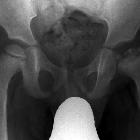double line sign






 nicht verwechseln mit: Doppelrandzeichen Hirnabszess
nicht verwechseln mit: Doppelrandzeichen HirnabszessThe double line sign is a pathognomonic MRI finding seen at the periphery of a region of osteonecrosis (avascular necrosis, bone infarct), representing the border between the viable and non-viable bone . It is best seen on T2 and T2 FS sequences and consists of two serpentine lines: an inner bright line representing reparative granulation tissue and an outer dark line representing adjacent sclerotic bone. The outer line is always continuous, while the inner line can be discontinuous or absent . This sign is reported in up to 80-85% of cases .
It should not be confused with the rim sign demarcating an osteochondral fragment with surrounding fluid (indicating that it is potentially unstable).
Practical points
The chemical shift artifact on non-fat-suppressed sequences can decrease the visibility of the double line sign, by either obscuring it or making it far more pronounced .
See also
Siehe auch:
- Aseptische Knochennekrose
- Knocheninfarkt
- Hüftkopfnekrose
- idiopathische kindliche Hüftkopfnekrose
- osteochondral fragment
- rim sign
und weiter:

 Assoziationen und Differentialdiagnosen zu Doppellinienzeichen Osteonekrose:
Assoziationen und Differentialdiagnosen zu Doppellinienzeichen Osteonekrose:



